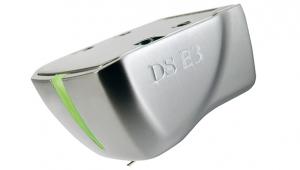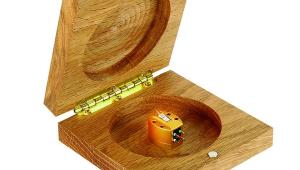Dr Feickert Twin (£3995 Without Arm)
Who better than a cartridge set-up maven to build a turntable? While any deck that accepts universal arms will, intrinsically, suffer an enormous margin for set-up errors when compared to decks with dedicated, integral arms, there’s something reassuring about the Feickert... especially for those who’ve used his set-up device. Someone that scarily anal just has to build a great deck.
From the outset, you know you’re not dealing with some schlemiel in a garage, with a Maplin catalogue, a coping saw and a prayer. The Turntable Twin has a finish that’s hard to fault, it oozes solidity and – to these eyes – it looks sensational, almost Bauhaus. A metal cylinder housing the motor, a thick platter, a black Perspex plinth, two stout rods exiting from the back to support an arm board, there’s nothing weak or flimsy about this LP spinner. The arm board slides along those rods, accommodating even 12in arms with ease. All together, it’s one of those rare devices that actually seems like it’s worth the money. In this case, a fiver short of £4000, less arm. And that’s serious cash by any measure.
ENERGY CONSCIOUS
Feickert states that, ‘One of the goals of the development was high immunity against sonic impact. To reach this goal we used an approach to transform unwanted energy in a mechanical absorption circuit. We call this method MARC (short for Mechanical Anti Resonant Circuit). And what is the result? Perfect conditions for tracking records.’
Feickert employs an inverted platter bearing beneath a massive platter, made of acrylic machined to accuracy greater than ‘1/100 mm in all dimensions’. Because the open architecture and modularity of this turntable encourage tweaking, Feickert offers a range of options, including a special platter with additional weights, providing up to three times the inertia in a bid to ‘enhance quietness, imaging and sovereignty.’
Another option is a choice of thread or belt drive; the review sample came with the thread, an almost-invisible filament. I’m assuming that thread drive has sonic advantages over the rubber belt, or the importer would have supplied the latter. Whatever the case, I have no prejudices in either direction. Also on the options list is a range of arm boards, and the facility to run this with two arms. Among those favoured by the designer are the S-shaped, Jelco-sourced arm fitted to this review sample and models from Kuzma, Mørch, Dynavector, SME and Graham.
Because the topology is wide open, set-up was a breeze, with easy access to the bolts holding the arm. The microprocessor controlled, quartz-reference, high-torque motor was positioned simply by fitting the thread; there was hardly any variation in the tension to allow it to be too far away, while too close would cause it to drop down. Six buttons control the motor, which runs at 33.3 and 45, with two controlling pitch. I set it up on the massive GM Accessori table, just right for the 460mm wide plinth, with the extra 150mm for the motor. Between 350mm-360mm should be allowed for the depth while overall height is around 190mm. Its weight? That’s 35 kilos.
FEICKERT, LET’S DANCE
With the delicious Transfiguration Orpheus moving-coil feeding the Audio Research PH5 phono stage, the McIntosh C2200/MC2102 pre/power combination and Sonus faber Cremona Auditor Elipsa, I tucked into a diet of live Dylan courtesy of Classic Records, an original pressing of Dennis Wilson’s Pacific Ocean Blue, mono magic from Connie Francis, Louis Prima and Mickey Katz, the 7in version of Mr Big’s ‘To Be With You’ and the Acoustic Sounds’ pressing of Creedence Clearwater Revival’s Pendulum. Initial impression? Cleanliness, allied to amazing solidity.
It’s hard not to think in (positive) digital terms, however purely analogue is the sound. A quarter-century after CD conditioned us to find as intrusive a smidgen of tracing noise, let alone the odd pop or click, it’s soul-reviving to hear LP playback this quiet. All the adjectives stolen from wine critics – silkiness, velvety blackness, yadayadayada – apply to the Feickert’s background silences, the acoustic guitars on ‘To Be With You’ bursting out of the stillness with the impact of a special effect in a 3D movie.
Naturally, such a clean slate on which to work means that low-level detail and dynamic extremes have an easier time working their way to your ears. With complex studio recordings, benefits include an ear into the layering of sound; you can tell that Dennis Wilson paid closer attention to brother Brian than his devil-may-care reputation suggests.
MASTER OF MONO
It’s arguable that such openness and transparency are needed less with stereo LPs than mono, the former being more open windows into the sound. But after the live Dylan material yielded some of the most cavernous acoustics one could want, convincingly wide and deep, I wondered if I should have listened first to the mono LPs.
Even with a fat single channel, though, the Feickert somehow managed to exercise all of its spatial and tonal prowess, the backing behind Connie Francis consisting of orchestral arrangements worthy of Sinatra-at-Capitol. Strings bore that wonderful sheen often lost in the transition from live to recorded, while her powerful, angst-torn vocals were so lifelike as to possess chill-power of operatic measure. Bloody-hell, could she wring all the pain out of a single note.
Staying with mono discs, Mickey Katz’s and Louis Prima’s punchy, tight recordings, both courtesy of 1950s Capitol, shared a misto of fast percussion, sharp brass and, for Prima, contrasting vocals: Louis duelling with Keely. With sound this commanding, this coherent and this rich, it’s only a matter of seconds before you stop thinking about mono vs stereo.
Can the sound be faulted? My SME 20/12 combination has a shade more weight in the lower registers, a trace more stage depth. But the Feickert is never shamed, never less than stunning.
VERDICT
Aside from the lack of a spacer for positioning the motor-housing – not terminally damning, as there’s little flex to the thread to encourage bad positioning – this deck ticked all the boxes: silent running, neutral sound, wide dynamics, superb build and finish, deliriously straightforward set-up and handsome looks. There’s an air of ‘rightness’ about this one, so buy with confidence.
Originally published in the October 2008 Issue



















































